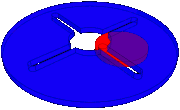
Instead of webs, the goldenrod crab spider, Misumena vatia, uses camouflage to ambush its prey, slowly changing color to match the flower on which it’s perched. It does this by moving yellow pigment closer to or farther from its outermost layer of cells. The species is most often found among yellow and white blooms, but it can morph into a green or bluish hue when necessary, or even take on reddish spots or stripes. Thus disguised, the arachnid waits frozen, its front legs poised to snap closed in a deadly embrace on hapless insects that come into range. The spider’s venomous bite can take down bugs as large as butterflies and bumblebees.

Here, a speckled sanddab nestles into the ocean floor, its skin mottled to mimic the pebbly background. A member of the flounder family, Citharichthys stigmaeus can change its topside appearance with cells called chromatophores. Pigment granules in these cells migrate closer to the cell surface to create patterns on its brown skin. This camouflage hides the fish from predators off the Pacific coast where it’s found and enables it to surprise its prey—smaller bony fishes, shrimp and worms.

Its unique black-and-white coloring helps the many-spotted tiger moth both stand out and blend in. Native to the western U.S., this moth may feed on mildly toxic plants like milkweed, taking the plant poisons into its own body as a natural defense against predators. Most often, the species’ white body advertises “I taste bad” to birds who spot it flying in the air, says biologist Rebecca Simmons of the University of North Dakota. But when it comes to rest against a dappled background, like the one pictured here, Hypercompe permaculata’s coloring also breaks up the outline of its body, allowing it to blend in and hide from birds that might not heed its white warning.

The round object in the center-right of this photo is no rock—it’s a rock ptarmigan hiding motionless among the stones and moss of the Alaskan tundra. (Look for its beak to spot its head.) In the winter snow, Lagopus muta exchanges its brown feathers for white, maintaining year-round protection from its main predator, the gyrfalcon. In the spring, males retain their white feathers after the snow disappears, advertising themselves to potential mates. Once they’ve mated, and before the brown feathers grow back, males roll around in the dirt, creating a makeshift camouflage, which is eventually replaced by a summer disguise like the one on the female shown here.

Huddled together against a rocky Canadian cliff face, a typical nesting site, these two gyrfalcon chicks blend into the marbled stone. Adult Falco rusticolus patrol the air in arctic regions, feeding on their tundra neighbors, the well-hidden ptarmigan and other smaller birds. Gyrfalcons are clad in inconspicuous gray, white and brown feathers, with a light underside.

Known for its distinctive high-pitched call, the spring peeper frog’s coloring ranges from grayish to reddish brown, a fitting adaptation to the leaves and dead grass of its wooded habitat in the eastern and midwestern United States. Darker markings, including the cross on its back, help break up Pseudacris crucifer’s silhouette against its surroundings. To add to the illusion, the tiny frog can also adjust its hue slightly within the gray-brown range to better match its environment.
Source: http://www.popsci.com/scitech/gallery/2008-11/hiding-plain-sight

















